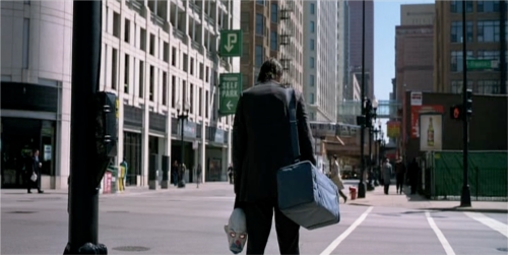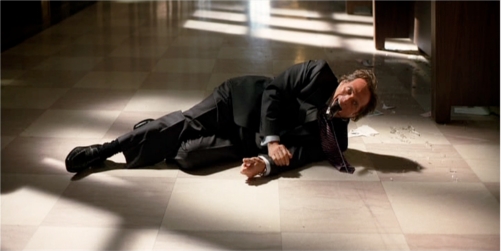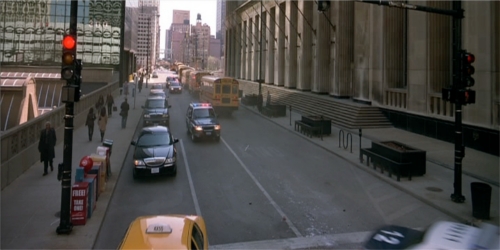
CJ Powers is an author/speaker
residing in the Chicagoland area. As a Writer/Director/Producer he
is an international script consultant and conducts screenwriting
workshops. His films released internationally and television programs
aired on CBS, PBS, ABC, the Family Channel, and various syndicated
stations. The majority of CJ’s directing awards, including the Silver
CINDY and Crystal Communicator of Excellence, were for family films. He
received additional honors from the U.S. and International Film and
Video Festival and the New York Film Festival.
|
Raising the Question |
|
The old rooftop in Greek town, with the Chicago skyline for a backdrop, served as a great location for my film project. The shoot was interrupted several times as the “Bat-helicopter” flew overhead, shooting background plates for The Dark Knight. Chicago had once again become the home of Gotham City and, since the production team had precedence over the area, I thought it was best to join them. Being in the movie made for some very long days, but – more importantly – I was thankful for the opportunity to learn from director Christopher Nolan and cinematographer Wally Pfister. While Wally and I shared a good laugh about Chicago’s ever-changing lighting conditions, I learned that Nolan’s drive was to keep the story interesting by raising questions within the minds of the viewer. Most filmmakers are aware that raising a universal question during Act 1 is critical to keeping the audience’s attention. By placing a central question during the set-up that resolves during the climax, the storyteller is able to keep the interest of the audience for the duration of the film. The viewer holds tight to their seats until they are able to answer the question residing in the forefront of their mind. In The Dark Knight, Nolan steps up the mystery by raising numerous questions to drive the audience from scene to scene. Questions are crafted out of the action plot conflict, interaction between characters, and artistic cinematography. The opening sequence is loaded with various questions which cause the audience to ask who of the clowns is gong to survive and whether one of them is the Joker. As the movie opens and the camera glides over the towers, the viewer questions what they should be looking at. Nolan answers the question with a shattering window. DAYLIGHT. Moving over the towers of downtown Gotham...Closing in on an office building...On a large window...Which SHATTERS to reveal – The next shot is tight on a smoking gun. The viewer questions if the Joker holds the gun. Nolan then reveals that two men are in the room wearing clown faces. INT. OFFICE, HIGH RISE – DAY The action shifts, causing the viewers to question what the clowns are up to and where they are going. After a cool shot of the two clowns sliding across the cable to the lower roof, Nolan cuts to a street scene and raises another question – Is this the Joker? EXT. DOWNTOWN GOTHAM – DAY  In the remainder of the five and a half minute opener, several more questions are raised. The series of rapid questions heightens the curiosity of the viewer and drives the pulse of the opening. It also raises the universal question about how crazy the Joker is or to what extreme he will go. |
Once the viewer is questioning the Joker’s sanity, Nolan launches the final sequence. INT. LOBBY, BANK – DAY  BOZO pulls off his MASK. THE JOKER. As the sequence concludes, Nolan reveals that the Joker is sane enough to mastermind an incredibly timed and intricate plan, including the camouflaged escape with the bus slipping into a line of buses as squad cars zoom toward the bank.  At the end of the sequence, the viewer knows that the Joker is crazy and sane enough to mastermind anything. The final question left in their mind is – What is the Joker going to do next and will Batman be able to stop him? The viewer is hooked and needs to watch the remainder of the film to find the answer. Few Christian films define a universal question to entice the viewer to stick around for the answer. Even less films use mini-questions to increase the viewer’s desire to watch the next scene. One of the differences between a good movie and a great movie is raising the curiosity of the audience to the point that they feel compelled to watch the next scene. Have you ever watched a great movie on DVD at a time when you needed to step out of the room, and you find yourself waiting for a lull in the plot before you go? If you find it difficult to push the pause button, it is likely due to a raised question that you are waiting to answer. A simple exercise to test the raising of questions in your previous films would be to pause the movie at the end of every scene and ask yourself what the question is that resides in the viewer’s mind. If it isn’t obvious, you have a hole in your story that will allow the viewer’s mind to drift into boredom. |








